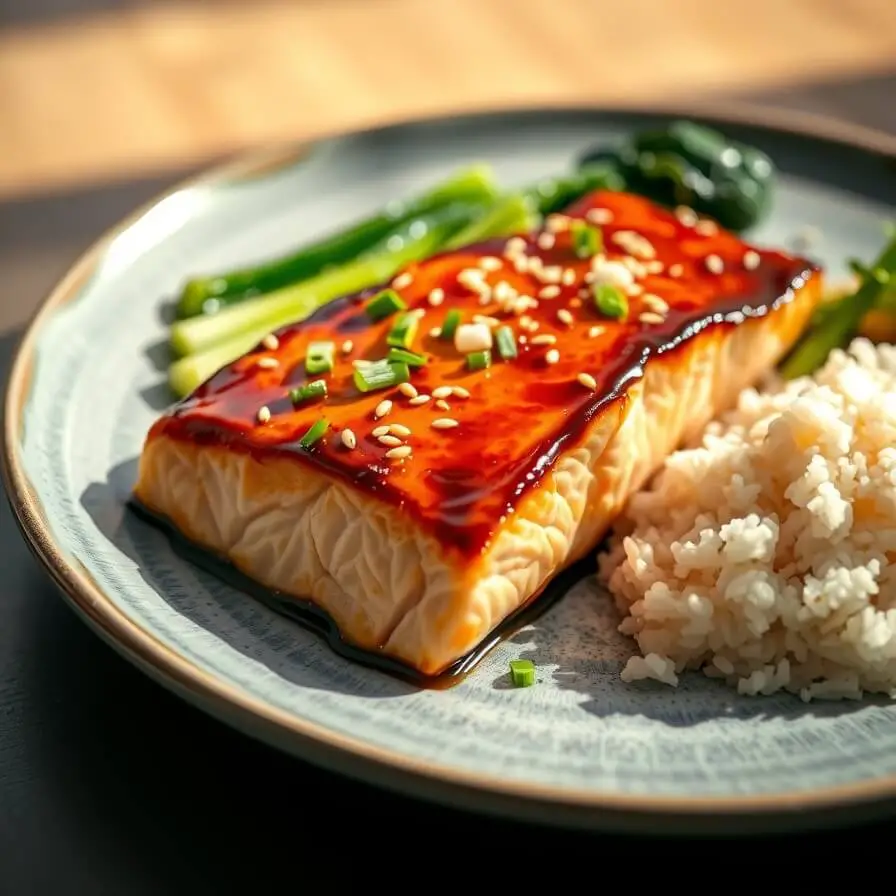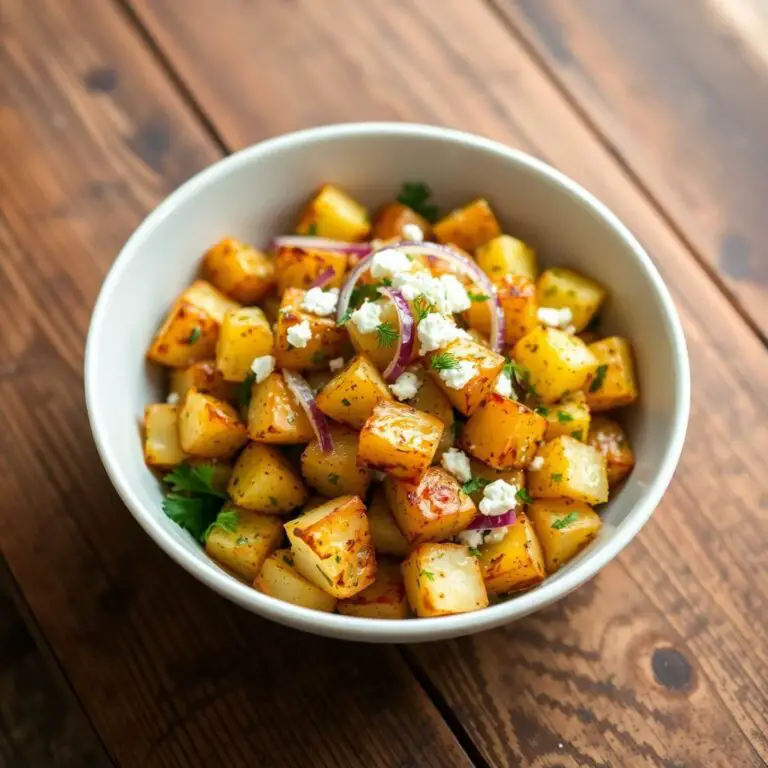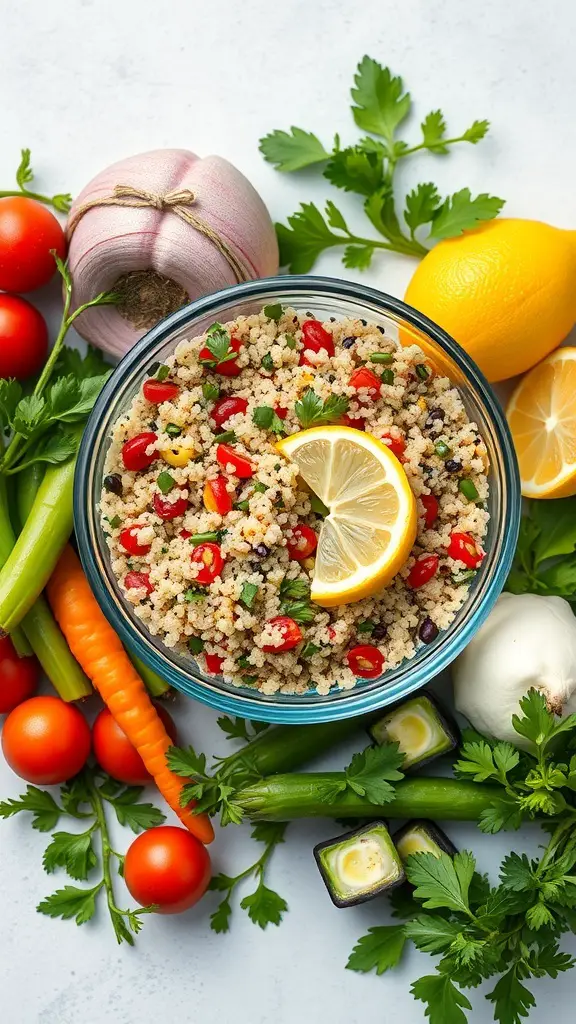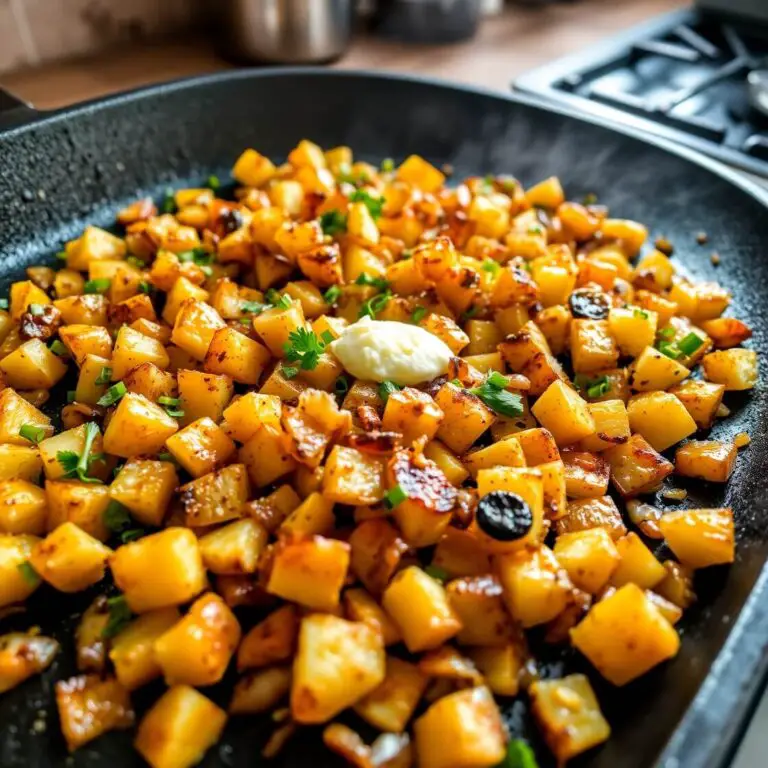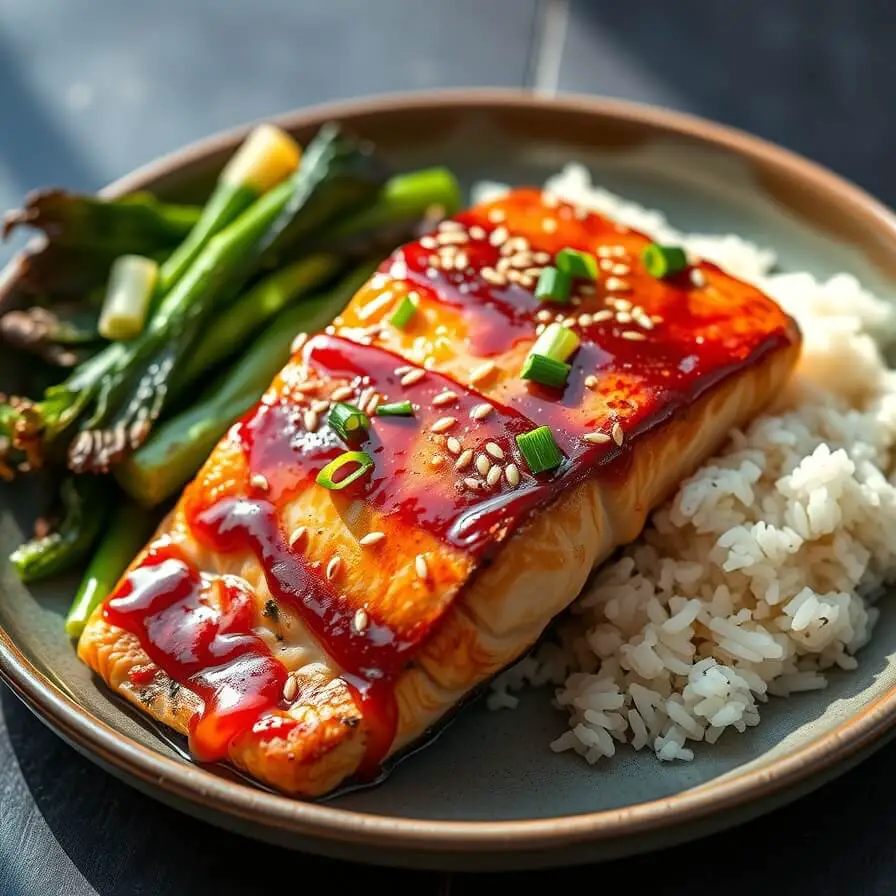
There’s something about miso salmon that feels like pure comfort with a touch of elegance. The first time I made it, I was trying to recreate a dish my husband and I had at a cozy Japanese restaurant tucked away in the city. It was one of those simple dinners that lingered in my memory — perfectly flaky salmon glazed with a salty-sweet sauce that melted into every bite. I remember thinking, “This can’t be that hard to make at home.” A few attempts later, and this version became a weeknight favorite that we now make almost every other week.
What I love about this miso salmon recipe is that it’s so unfussy but delivers restaurant-quality flavor. The marinade takes only minutes to whip up, and the oven (or air fryer, if you prefer) does most of the work. You’ll end up with tender, buttery salmon that’s deeply infused with umami flavor from the miso, balanced by a hint of sweetness and brightness from mirin and ginger. It’s one of those dishes that feels indulgent but is secretly healthy and ridiculously easy to pull off — the kind that impresses guests but also works beautifully for a quiet dinner at home.
Why I Love This Recipe
If you’ve ever had miso soup, you already know the flavor magic that miso paste brings — it’s savory, earthy, and full of depth. But when it’s paired with salmon, something truly special happens. The natural richness of the fish blends with the slightly salty-sweet miso glaze, creating an irresistible umami bomb that’s both comforting and refined.
I love this recipe because it feels luxurious without being complicated. It’s perfect for busy weeknights when you want something nourishing yet impressive. I usually marinate the salmon in the morning before work — the miso, soy sauce, and mirin soak in all day, creating a glaze that caramelizes beautifully when baked or broiled.
Another reason I adore this dish is its versatility. You can serve it over rice for a cozy dinner, alongside roasted veggies for a lighter option, or even flake the salmon into a salad the next day. It’s also great for meal prep — the flavor only deepens as it rests, making leftovers even better.
And honestly, there’s just something satisfying about cooking with miso paste. It’s one of those ingredients that feels “gourmet” but is actually very approachable. A little goes a long way, and it adds that elusive savory depth that keeps people guessing what your secret ingredient is.
Ingredients for Miso Salmon
Let’s talk ingredients — and more importantly, what makes each one shine in this recipe.
You’ll need:
- Salmon fillets: I prefer skin-on salmon because the skin helps keep the fish moist while baking. You can use Atlantic, Coho, or Sockeye — whatever’s freshest. Just make sure the fillets are roughly the same thickness so they cook evenly.
- White miso paste: This is the heart of the dish. White miso (shiro miso) is mild and slightly sweet, which pairs perfectly with salmon. Red miso will work too, but it has a stronger, saltier flavor, so reduce the amount slightly if you go that route.
- Soy sauce: Adds umami and saltiness that enhances the miso. I usually go for low-sodium soy sauce so I can control the salt better.
- Mirin: A sweet Japanese rice wine that gives the glaze a gentle sweetness and sheen. If you don’t have mirin, a mix of rice vinegar and a bit of honey or sugar works just as well.
- Sesame oil: A little drizzle adds a nutty aroma that rounds out the flavors.
- Fresh ginger: Brightens the marinade with a subtle zing that cuts through the richness of the salmon.
- Garlic: Because garlic makes everything better.
- Brown sugar or honey: Just enough to balance the saltiness of the miso and soy. Honey gives the glaze a glossy finish when broiled.
- Rice vinegar or lemon juice: A touch of acidity to keep the flavors balanced and fresh.
The beauty of these ingredients is how easily they come together — whisked into a silky marinade that clings beautifully to the salmon, ensuring every bite is flavorful.
How Much Time Will You Need
From start to finish, this miso salmon recipe takes about 30 minutes, plus optional marinating time.
- Prep time: 10 minutes to make the marinade and coat the salmon.
- Marinating time: Ideally 30 minutes to 2 hours (or even overnight in the fridge if you’re planning ahead).
- Cooking time: 12 to 15 minutes in the oven, depending on the thickness of your salmon.
If you’re in a rush, you can skip the long marinade — even 15 minutes makes a noticeable difference. I often do a quick version when I need dinner on the table fast, and it still turns out deliciously flavorful.
How to Make This Miso Salmon
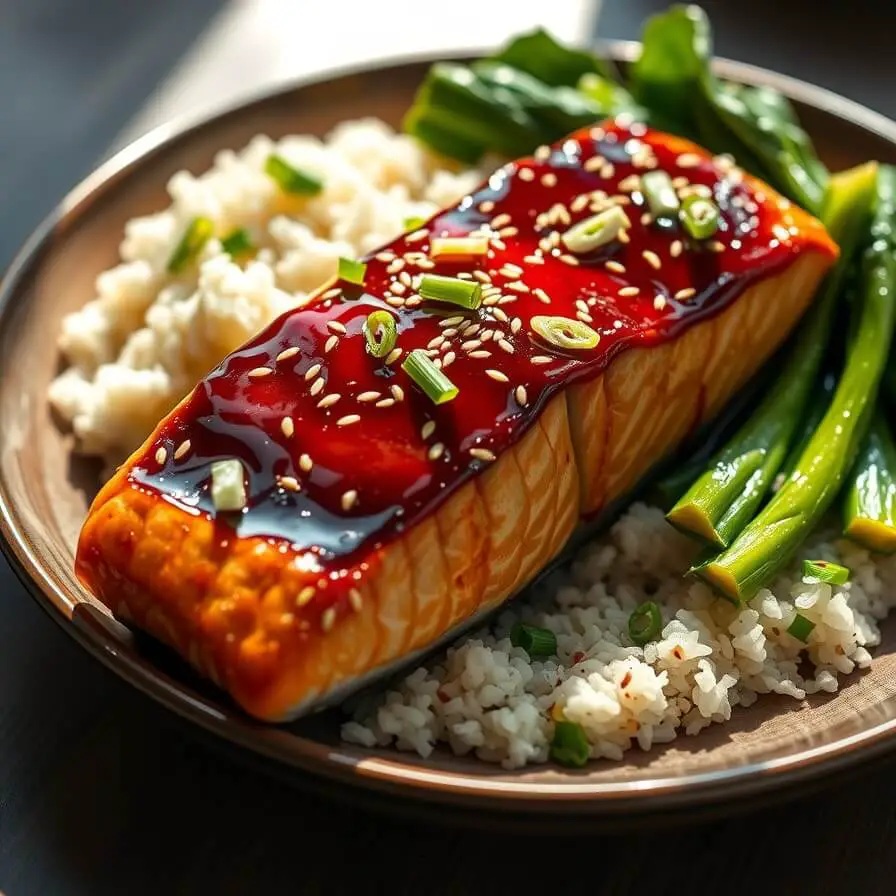
Step – 1: Prepare the Marinade
In a small bowl, whisk together the miso paste, soy sauce, mirin, sesame oil, minced garlic, grated ginger, and a touch of brown sugar or honey. Whisk until smooth and glossy. The texture should be thick but pourable — like a creamy glaze. Taste it; it should be balanced between salty, sweet, and tangy. Adjust with a splash of rice vinegar or more honey if needed.
Step – 2: Marinate the Salmon
Pat your salmon fillets dry with a paper towel. Place them in a shallow dish or a resealable bag, skin-side down, and pour the miso mixture over the top. Use a spoon or your hands to coat each piece evenly. Cover and refrigerate for at least 30 minutes (up to overnight). The longer it marinates, the deeper the flavor seeps in.
Step – 3: Preheat and Prepare
When you’re ready to cook, preheat your oven to 400°F (200°C). Line a baking sheet with foil or parchment paper for easy cleanup. Lightly grease it with a bit of oil or cooking spray.
Step – 4: Bake or Broil
Place the salmon skin-side down on the prepared sheet. Bake for 12–15 minutes, depending on thickness, until the fish flakes easily with a fork. For a restaurant-style caramelized finish, switch to the broiler for the last 1–2 minutes — watch closely so it doesn’t burn.
Step – 5: Optional Glaze
If you like a saucier salmon (I always do), reserve a tablespoon of the marinade (before adding it to raw fish). Heat it in a small pan with a teaspoon of honey until slightly thickened, then drizzle it over the cooked salmon before serving.
Step – 6: Serve and Enjoy
Transfer your salmon to a plate, sprinkle with sesame seeds or chopped scallions, and serve hot. The aroma alone will have everyone gathered around the table.
Substitutions
One of the best things about this recipe is its flexibility. Here are some easy swaps if you don’t have everything on hand:
- Miso paste: If you can’t find white miso, use red or mixed miso — just use a bit less since they’re saltier. In a pinch, you can mix tahini with soy sauce and a bit of rice vinegar for a similar savory depth.
- Mirin: Combine rice vinegar with a small amount of honey or sugar for a close substitute.
- Salmon: This recipe works beautifully with other fish like cod, halibut, or even chicken thighs.
- Soy sauce: Tamari or coconut aminos are great gluten-free alternatives.
- Sweetener: Brown sugar, maple syrup, or honey all add a lovely caramelized glaze.
These substitutes make the dish approachable no matter what’s in your pantry — the key is balancing that signature miso-sweet-savory harmony.
Best Side Dishes for Miso Salmon
A perfectly cooked miso salmon deserves equally satisfying sides. Here are a few of my favorites:
- Garlic Fried Rice: The rich miso glaze pairs beautifully with garlicky rice. The mild sweetness of the fish balances the savory rice perfectly.
- Steamed Bok Choy with Sesame Oil: A light and earthy side that adds freshness and crunch to your plate.
- Roasted Sweet Potatoes: Their natural sweetness complements the umami notes of the miso glaze — plus, they look beautiful when plated together.
These sides create a balanced meal that feels nourishing and comforting without being heavy — exactly what I crave after a long day.
Serving and Presentation Tips
There’s something magical about serving miso salmon straight from the oven — the glaze glistening, the aroma filling the kitchen, and the first bite melting in your mouth. But with just a few simple touches, you can elevate this humble dish into a restaurant-worthy meal.
I like to serve my miso salmon on a shallow white plate or a dark ceramic dish — the contrast makes the amber glaze pop beautifully. Spoon a bit of extra glaze or pan juices over the top to give it that irresistible sheen. Then sprinkle a few toasted sesame seeds or finely sliced green onions for color and crunch.
If you’re serving guests, consider plating it with a small mound of jasmine rice or soba noodles underneath. Drizzle a light soy-ginger sauce around the plate, and maybe add a few microgreens or pickled radish slices for a touch of sophistication.
For a more casual, weeknight presentation, I sometimes flake the salmon over a bowl of steamed rice and vegetables — a quick miso salmon rice bowl that feels just as comforting as it looks beautiful.
Tips and Tricks to Make This Recipe Even Better
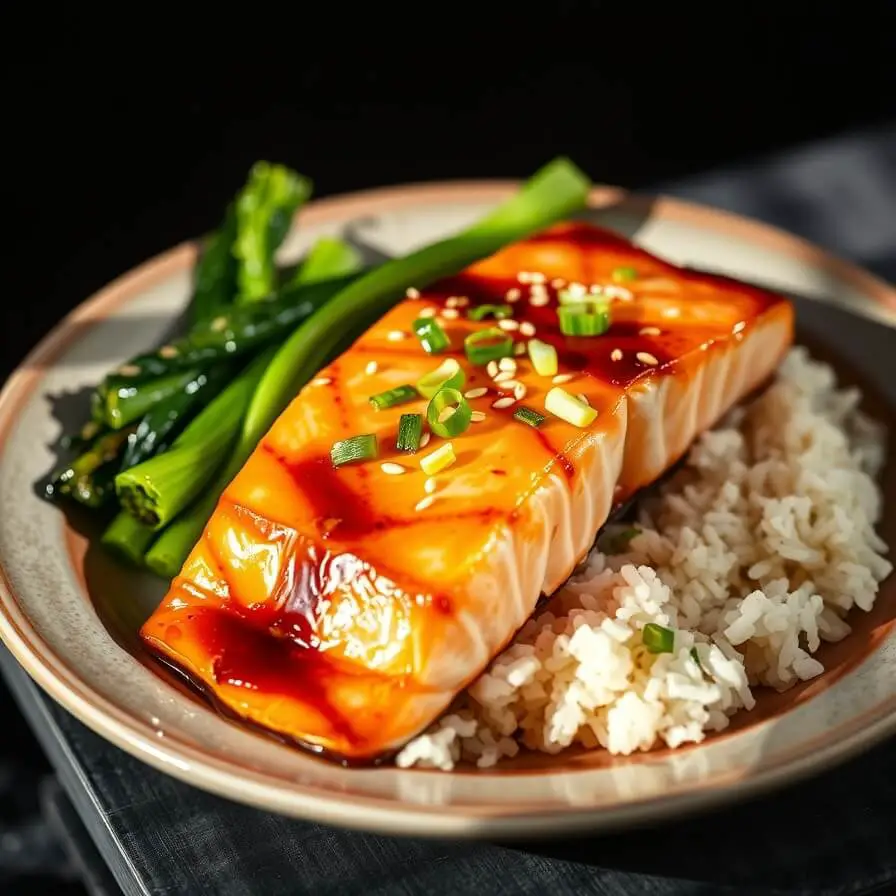
Here’s the thing about miso salmon: it’s already wonderful on its own, but a few thoughtful tweaks can take it from great to unforgettable.
1. Don’t over-marinate.
While miso is delicious, it’s also salty. Marinating the salmon for more than 24 hours can make it too intense and slightly dry. A good rule of thumb is 30 minutes to 8 hours — plenty for the flavors to sink in.
2. Let the salmon come to room temperature before baking.
This ensures even cooking and prevents the edges from overcooking while the center stays raw.
3. Use parchment paper or foil for easy cleanup.
The miso glaze can get sticky as it caramelizes, so lining your pan saves a lot of scrubbing later.
4. Broil for the last minute.
This is the secret to that perfect, glossy finish. Watch closely — it goes from golden to burnt quickly!
5. Try it in an air fryer.
If you’re short on time, air fry the salmon at 375°F for about 8–10 minutes. It’ll be crisp on the edges and tender inside — just divine.
6. Balance the flavors.
If your miso paste is on the saltier side, cut back a bit on soy sauce or add an extra drizzle of honey to even things out.
7. Make extra glaze.
Trust me — you’ll want it. It’s perfect drizzled over rice, veggies, or even grilled tofu.
Common Mistakes to Avoid
Every cook has a learning curve, and I’ve made my fair share of miso salmon blunders. Here’s how to avoid them:
1. Using too much miso paste.
It’s tempting to add more for extra flavor, but miso is powerful. Too much can overpower the fish and make it overly salty.
2. Skipping the drying step.
Always pat the salmon dry before marinating. Excess moisture prevents the glaze from sticking properly.
3. Overcooking the salmon.
This is the most common mistake. Salmon continues to cook after it’s removed from the oven, so pull it out just as it flakes easily. It should still be moist inside.
4. Forgetting to taste the marinade.
Everyone’s miso paste is different — some saltier, some sweeter. Always taste and adjust before marinating your fish.
5. Not broiling at the end.
That final broil creates the caramelized, slightly crisp edges that make miso salmon so irresistible.
How to Store It
If you have leftovers (which, honestly, is rare in my kitchen), miso salmon keeps beautifully for up to 3 days in the refrigerator. Store it in an airtight container once it’s completely cooled.
To reheat, I recommend using a gentle method to preserve the moisture. Place the salmon in a covered dish and warm it in a 300°F oven for about 10 minutes, or microwave it briefly with a damp paper towel over the top to prevent drying out.
You can also flake cold miso salmon over salads or rice bowls for an easy next-day lunch. It tastes just as good chilled!
If you’d like to store it longer, cooked miso salmon freezes well. Wrap each fillet tightly in foil or plastic wrap, then place it in a freezer-safe bag. Thaw overnight in the refrigerator before reheating.
FAQ
Q: Can I make miso salmon without mirin?
Yes! If you don’t have mirin, mix rice vinegar with a bit of honey or sugar for a similar sweet-acidic balance.
Q: What kind of miso is best for this recipe?
White (shiro) miso is ideal because of its mild, slightly sweet flavor. Red miso is stronger and saltier, but you can use it if you reduce the amount slightly.
Q: Can I cook this in a skillet instead of baking?
Absolutely. Heat a nonstick pan over medium heat, cook the salmon skin-side down for 3–4 minutes, then flip and brush with glaze until cooked through.
Q: Is miso salmon healthy?
Yes — it’s rich in omega-3 fatty acids, high in protein, and made with nutrient-dense ingredients like miso and ginger.
Q: Can I use frozen salmon?
Yes, just thaw it completely and pat it dry before marinating so the glaze adheres properly.

Miso Salmon Recipe
- Total Time: 25 minutes
- Yield: 2–4 1x
- Diet: Gluten Free
Description
A beautifully glazed, umami-rich miso salmon that’s tender, flavorful, and ready in just 30 minutes. The perfect balance of sweet, savory, and slightly tangy flavors makes this dish a weeknight favorite or a dinner-party showstopper. The miso-based marinade infuses the salmon with deep, comforting flavor, while a quick broil at the end gives it that irresistible caramelized finish. Serve it with rice, veggies, or noodles for a complete, satisfying meal.
Ingredients
- 2 salmon fillets (skin-on, 5–6 oz each)
- 2 tbsp white miso paste
- 1½ tbsp soy sauce (low-sodium)
- 1 tbsp mirin (or rice vinegar + ½ tsp honey)
- 1 tsp sesame oil
- 1 clove garlic, minced
- 1 tsp grated fresh ginger
- 1 tsp brown sugar or honey
- ½ tsp rice vinegar or lemon juice
- Sesame seeds and chopped scallions, for garnish
Instructions
- In a small bowl, whisk miso paste, soy sauce, mirin, sesame oil, ginger, garlic, and honey until smooth.
- Pat salmon dry and place it in a shallow dish. Pour marinade over the fish and coat evenly. Let marinate for 30 minutes to 2 hours in the fridge.
- Preheat oven to 400°F (200°C). Line a baking tray with foil or parchment.
- Bake salmon for 12–15 minutes or until just cooked through. For caramelized edges, broil for 1–2 minutes at the end.
- Garnish with sesame seeds and scallions. Serve hot.
Notes
- For extra glaze, reserve a spoonful of marinade before coating the salmon and heat it into a sauce.
- Don’t overcook the salmon — it should flake easily but stay moist.
- Air fryer option: cook at 375°F for 8–10 minutes.
- Prep Time: 10 minutes
- Cook Time: 15 minutes
- Category: Main Dish
- Method: Baking or Broiling
- Cuisine: Japanese-inspired
Nutrition
- Serving Size: 2–4
- Calories: 320
- Sugar: 5g
- Sodium: 610mg
- Fat: 20g
- Saturated Fat: 3g
- Unsaturated Fat: 14g
- Trans Fat: 0g
- Carbohydrates: 8g
- Fiber: 0g
- Protein: 27g
- Cholesterol: 70mg

